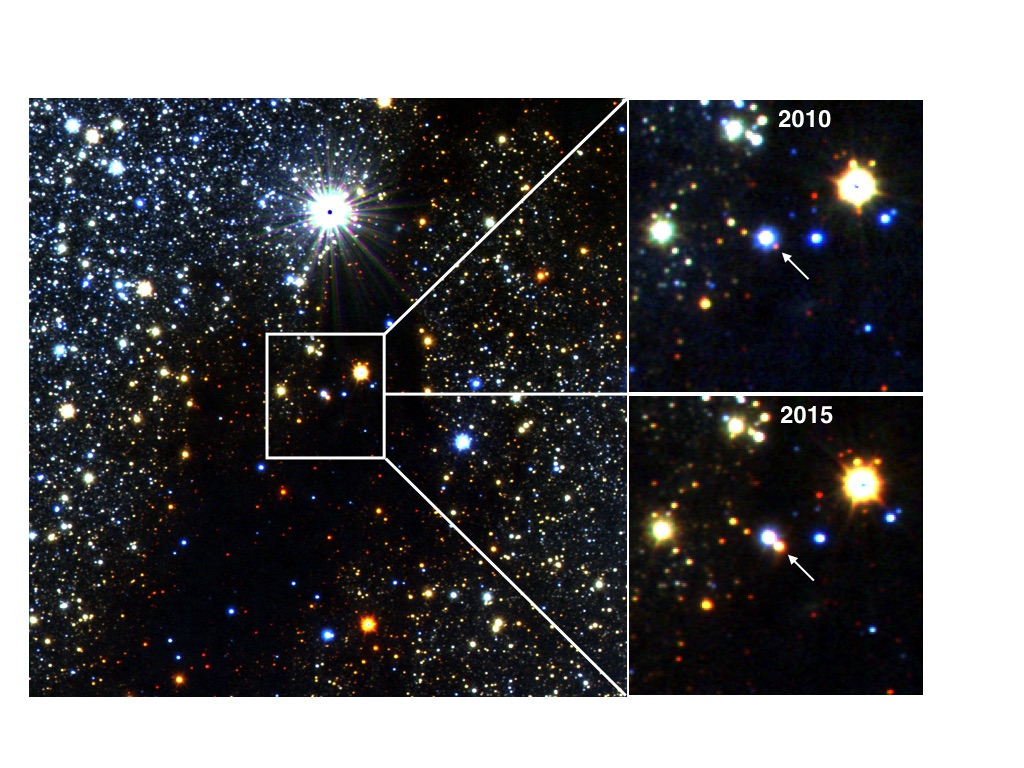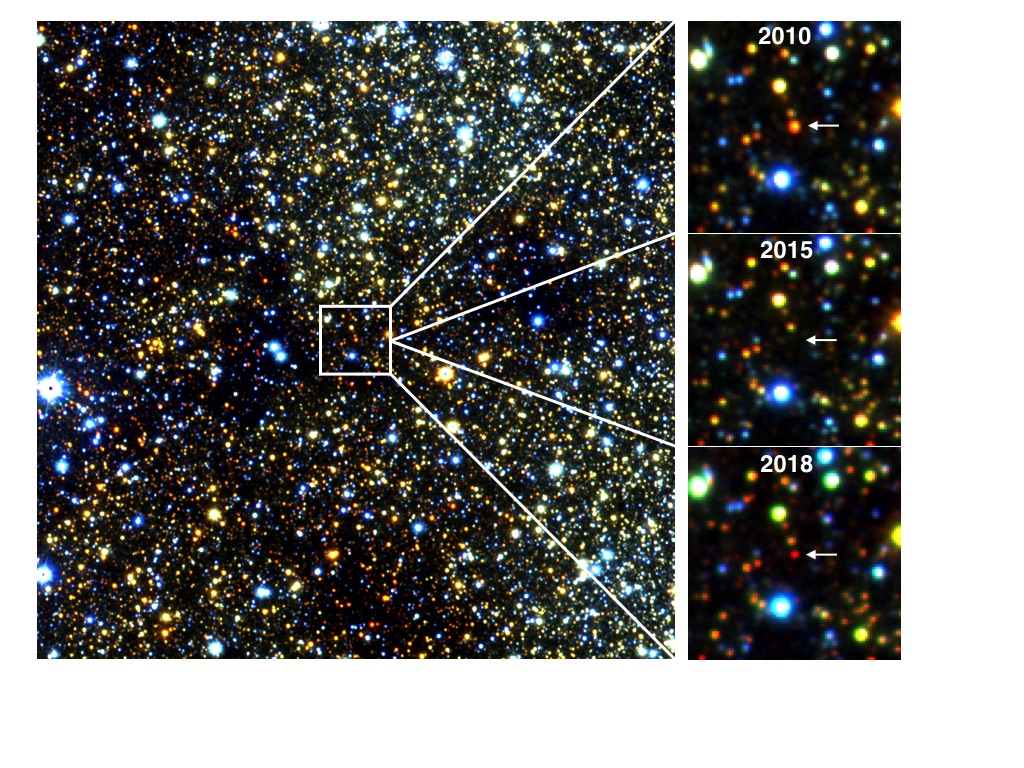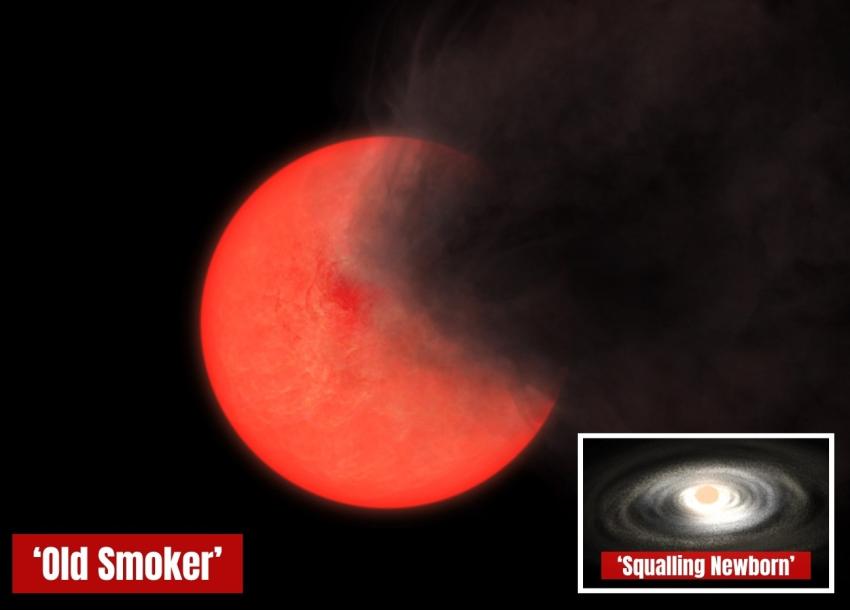'Hidden' stars including a new type of elderly giant nicknamed an 'old smoker' have been spotted for the first time by astronomers.
The mystery objects exist at the heart of our Milky Way galaxy and can sit quietly for decades – fading almost to invisibility – before suddenly puffing out clouds of smoke, according to a new study published today in the Monthly Notices of the Royal Astronomical Society.
An international team of scientists led by Professor Philip Lucas, of the University of Hertfordshire, made their ground-breaking discovery after monitoring almost a billion stars in infrared light during a 10-year survey of the night sky.
They also detected dozens of rarely-seen newborn stars, known as protostars, which undergo extreme outbursts over a period of months, years or decades, as part of the formation of a new solar system.
Most of these newly-spotted stars are hidden from view in visible light by large amounts of dust and gas in the Milky Way – but infrared light can get through, allowing scientists to see them for the first time.
Astronomers from the UK, Chile, South Korea, Brazil, Germany and Italy carried out their research with the help of the Visible and Infrared Survey Telescope (VISTA) – a British-built telescope high in the Chilean Andes at Cerro Paranal Observatory, which is part of the European Southern Observatory (ESO).
The team kept a watchful eye on hundreds of millions of stars and analysed 222 that showed the largest changes in brightness.
Professor Lucas said: "About two-thirds of the stars were easy to classify as well-understood events of various types.
"The rest were a bit more difficult so we used ESO's Very Large Telescope to get spectra of many of them individually. A spectrum shows us how much light we can see at a spread of different wavelengths, giving a much clearer idea of what we are looking at."
The work was carried out as part of a long-term survey called 'VISTA Variables in the Via Lactea', or VVV.
Dr Zhen Guo, formerly of the University of Hertfordshire and now based at the University of Valparaiso in Chile, led the work on the spectra.
He said: "Our main aim was to find rarely-seen newborn stars, also called protostars, while they are undergoing a great outburst that can last for months, years, or even decades.
"These outbursts happen in the slowly spinning disc of matter that is forming a new solar system. They help the newborn star in the middle to grow, but make it harder for planets to form.
"We don't yet understand why the discs become unstable like this."
The team discovered 32 erupting protostars that increased in brightness at least 40-fold, and in some cases over 300-fold.

Most of the eruptions are still ongoing, allowing astronomers for the first time to analyse a large batch of these mysterious events throughout their evolution – from the initial quiescent state, through the peak of brightness, and into the declining stage.
However, the study also threw up something completely unexpected.
There were 21 red stars near the centre of the Milky Way that showed ambiguous changes in brightness during the 10-year survey.
Professor Lucas explained: "We weren’t sure if these 21 stars were protostars starting an eruption, squalling newborns if you will, or recovering from a dip in brightness caused by a disc or shell of dust in front of the star.
"A third option was that they were older giant stars throwing off matter in the late stages of their life, puffing out gas like old smokers."
Analysis of the spectra for seven of these stars, compared with data from earlier surveys, concluded that they were in fact a new type of red giant star.

Professor Dante Minniti at Andrés Bello University, Chile, founder of the VVV survey, said: "These elderly stars sit quietly for years or decades and then puff out clouds of smoke in a totally unexpected way.
"They look very dim and red for several years, to the point that sometimes we can't see them at all."
A further clue about this new discovery lies in the location of these dwindling giant stars. They are heavily concentrated in the innermost part of the Milky Way, known as the Nuclear Disc, a region where stars tend to be richer in heavy elements than anywhere else.
This should make it easier for dust particles to condense out of gas in the relatively cool outer layers of red giant stars. However, how this leads to the ejection of puffs of dense smoke that the team observed remains a mystery.
The researchers said their discoveries could change what we know about the way that elements are distributed across space, as Professor Lucas explains.
"Matter ejected from old stars plays a key role in the life cycle of the elements, helping to form the next generation of stars and planets," he said.
"This was thought to occur mainly in a well-studied type of star called a Mira variable.
"However, the discovery of a new type of star that throws off matter could have wider significance for the spread of heavy elements in the Nuclear Disc and metal-rich regions of other galaxies."
The papers 'The most variable VVV sources: eruptive protostars, dipping giants in the Nuclear Disc and others', 'Spectroscopic confirmation of high-amplitude eruptive YSOs and dipping giants from the VVV survey' and 'On the incidence of episodic accretion in Class I YSOs from VVV' have all been published in the Monthly Notices of the Royal Astronomical Society.
Media contacts
Sam Tonkin
Royal Astronomical Society
Mob: +44 (0)7802 877700
Robert Massey
Royal Astronomical Society
Mob: +44 (0)7802 877699
Images and captions
All images in this release are public domain.
A newborn star erupts: Buried deep inside the dark cloud of gas and dust that fills the picture, this star gradually brightened 40-fold over the course of two years and has remained bright since 2015. The cause of such events is not clearly understood. This infrared image shows what we would see if our eyes were sensitive to wavelengths three times longer than visible light.
Red giant star: Infrared images of a red giant star about 30,000 light years away, near the centre of our Milky Way galaxy, which faded away and then reappeared over the course of several years.
Newborn star eruption: Artist's impression of an eruption in the disc of matter around a newborn star. The innermost part of the disc becomes hotter than the star itself.
Obscured red giant star: Artist's impression of a cloud of smoke and dust being thrown out by a red giant star. Seen from the left the star remains bright but if viewed from the right it fades to invisibility.
Science contacts
Professor Philip Lucas, University of Hertfordshire
Tel: +44 (0)7951 630957
Professor Dante Minniti, Universidad Andres Bello, Chile, the Vatican Observatory and Universidade Federal de Santa Catarina, Brazil
Tel: +562 2661 7893
Further information
The papers are available via the links below:
https://academic.oup.com/
https://academic.oup.com/
https://academic.oup.com/
https://academic.oup.com/
Researchers and affiliations
Philip W. Lucas 1 , Zhen Guo 2, 3, 1, 4, Carlos Contreras Peña 5, Leigh Smith 6, Dante Minniti 7, 8, 9, Radostin Kurtev 2, 10, Jura Borissova 2, 10, Niall Miller 1, Javier Alonso-García 11, 10, Marcio Catelan 12,10, Sergey Yurchenko 13, Roberto K. Saito 9, Amelia Bayo 14, Dirk Froebrich 15, Alessio Caratti o Garatti 16, Maria Gabriela Navarro 17, Calum Morris 1, Hariharan D.S. Muthu 1, Valentin D. Ivanov 14, Jason L. Sanders 13, Jonathan Tennyson 13, K. Maucó 9, 3, A. Aguayo 2, 3.
(1) University of Hertfordshire, Hatfield, UK
(2) Universidad de Valparaí́so, Valparaí́so, Chile
(3) Núcleo Milenio de Formación Planetaria, Valparaíso, Valparaíso, Chile
(4) Universidad Técnica Federico Santa María, Valparaíso, Chile
(5) Seoul National University, Seoul, Republic of Korea
(6) University of Cambridge, Cambridge, UK
(7) Universidad Andres Bello, Santiago, Chile
(8) Vatican Observatory, Vatican City State, Italy
(9) Universidade Federal de Santa Catarina, Florianópolis, Brazil
(10) Millennium Institute of Astrophysics, Santiago, Chile
(11) Universidad de Antofagasta, Antofagasta, Chile
(12) Pontificia Universidad Católica de Chile, Santiago, Chile
(13) University College London, London, UK
(14) European Southern Observatory, Garching, Germany
(15) University of Kent, Canterbury, UK
(16) Osservatorio Astronomico di Capodimonte, Napoli, Italy
(17) Osservatorio Astronomico di Roma, Monte Porzio Catone, Italy
Notes for editors
About the Royal Astronomical Society
The Royal Astronomical Society (RAS), founded in 1820, encourages and promotes the study of astronomy, solar-system science, geophysics and closely related branches of science. The RAS organises scientific meetings, publishes international research and review journals, recognises outstanding achievements by the award of medals and prizes, maintains an extensive library, supports education through grants and outreach activities and represents UK astronomy nationally and internationally. Its more than 4,000 members (Fellows), a third based overseas, include scientific researchers in universities, observatories and laboratories as well as historians of astronomy and others.
The RAS accepts papers for its journals based on the principle of peer review, in which fellow experts on the editorial boards accept the paper as worth considering. The Society issues press releases based on a similar principle, but the organisations and scientists concerned have overall responsibility for their content.
Keep up with the RAS on X, Facebook, LinkedIn and YouTube.
About the University of Hertfordshire
From our pioneering beginnings as a leading educator within Britain’s aeronautical industry to our extensive offering today, we have always specialised in providing the environment and expertise needed to power every kind of potential. We target and fill key skills gaps. We deliver globally-recognised research. And we partner with industry to drive innovation and growth, here in the region and well beyond.
For our thriving community of more than 30,000 students from over 140 countries, that means high- quality teaching from experts engaged in pioneering research with real-world impact. Access to over 550 career-focused degree options and a chance to study at more than 170 universities worldwide. And industry connections that offer professional networking opportunities which take talents even further.
Herts: Discover a place where ideas move at a different pace.
Visit herts.ac.uk
Read more about astrophysics research at the University of Hertfordshire.
About VISTA
Visible and Infrared Survey Telescope (VISTA), a British-built telescope high in the Chilean Andes at Cerro Paranal Observatory, part of the European Southern Observatory (ESO). VISTA was designed to survey large parts of the sky with a 67 Mega-pixel infrared camera, the largest of its type in the world.


